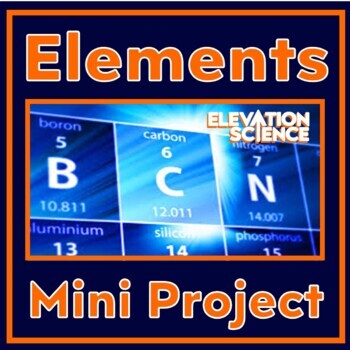Chemical Element Mini Research Project Atomic Structure and Physical Properties
Elevation Science
639 Followers
Grade Levels
6th - 9th
Subjects
Resource Type
Standards
CCSSRST.6-8.1
CCSSRST.6-8.4
CCSSRST.6-8.7
NGSSMS-PS1-1
Formats Included
- PDF
- Easel Activity
Pages
2 pages
Elevation Science
639 Followers
Easel Activity Included
This resource includes a ready-to-use interactive activity students can complete on any device. Easel by TPT is free to use! Learn more.
Description
Quick project for an elements of the periodic table unit! Supports students' understanding of atomic structure and gives them a closer look at one element.
This document includes detailed project instructions and a template on which students can enter the information they find.
In this activity, students will:
- Pick one element to research.
- Draw the atomic structure of the atom.
- Research the element's physical characteristics, discovery, and uses.
Teacher Notes:
- A grading guide is embedded in the instructions. Each section is assigned a certain number of points.
- This resource is not editable.
- Suggested websites for student research are included in the teacher notes section.
Please consider clicking HERE to follow Elevation Science on TPT!
Total Pages
2 pages
Answer Key
Does not apply
Teaching Duration
90 minutes
Last updated Nov 27th, 2015
Report this resource to TPT
Reported resources will be reviewed by our team. Report this resource to let us know if this resource violates TPT’s content guidelines.
Standards
to see state-specific standards (only available in the US).
CCSSRST.6-8.1
Cite specific textual evidence to support analysis of science and technical texts.
CCSSRST.6-8.4
Determine the meaning of symbols, key terms, and other domain-specific words and phrases as they are used in a specific scientific or technical context relevant to grades 6–8 texts and topics.
CCSSRST.6-8.7
Integrate quantitative or technical information expressed in words in a text with a version of that information expressed visually (e.g., in a flowchart, diagram, model, graph, or table).
NGSSMS-PS1-1
Develop models to describe the atomic composition of simple molecules and extended structures. Emphasis is on developing models of molecules that vary in complexity. Examples of simple molecules could include ammonia and methanol. Examples of extended structures could include sodium chloride or diamonds. Examples of molecular-level models could include drawings, 3D ball and stick structures, or computer representations showing different molecules with different types of atoms. Assessment does not include valence electrons and bonding energy, discussing the ionic nature of subunits of complex structures, or a complete depiction of all individual atoms in a complex molecule or extended structure.






